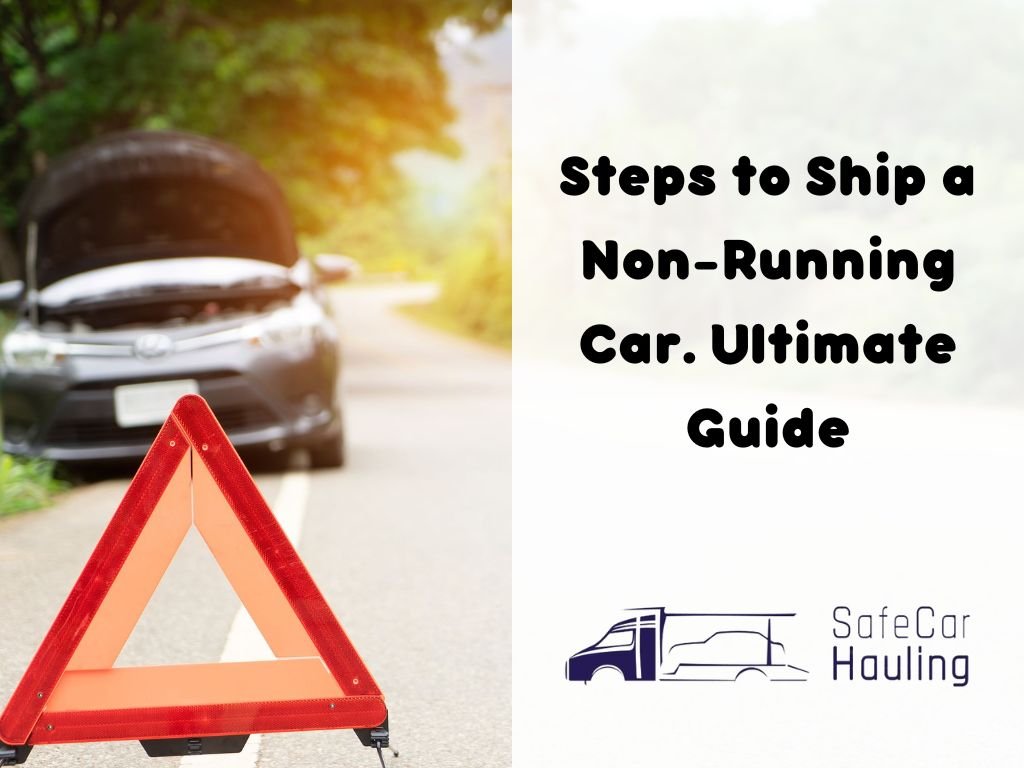Have you ever found yourself needing to transport a car that just won’t start? Whether it’s a vintage classic, a project car waiting for restoration, or simply a vehicle that’s seen better days, shipping a non-running car comes with its set of challenges. This guide is designed to walk car enthusiasts, moving companies, and vintage car collectors through the process, making what seems daunting a lot more manageable.
Get a car shipping quote in seconds!
Instant QuoteWhy Cars Stop Running
Cars, like all machines, have their lifespans and quirks. The most common reasons for a car to become inoperable include mechanical failure, electrical issues, or the age-related wear and tear that afflicts vintage beauties. Special considerations must be made for classic cars, as their value is not just in their appearance but in their historical significance and irreplaceability. Selecting a door-to-door shipping service can simplify this scenario, as it allows the carrier to pick up the vehicle directly from your home.
Preparing a Non-Running Car for Shipping
Before your car can be loaded onto a trailer and transported, several steps need to be taken to ensure its safety and to protect it from further damage:
- Secure Loose Parts: Any parts of the car that are loosely attached should be secured or removed and shipped separately.
- Close All Windows: This protects the interior from dust and debris.
- Document Existing Damage: Taking photos and documenting any existing damage can help in the unlikely event of a shipping dispute.
Both the car owner and the shipping company play roles in preparation, with the company often advising on or directly assisting with these tasks.
Choosing the Right Shipping Method
With options ranging from enclosed trailers to flatbed trucks, each shipping method offers different levels of protection and cost:
- Enclosed Shipping: Enclosed transport involves housing the vehicle within a trailer or a similar secure setting during shipment. Although this option is pricier than open transport, it offers superior safety by safeguarding the car throughout the journey. However, it’s important to note that if your vehicle is unable to steer or roll, enclosed transport may not be feasible.
- Open Shipping: Open transport stands as the market’s most cost-effective and favored choice. However, the primary drawback is the exposure of your vehicle to road debris, making it less ideal for transporting classic cars when preserving the paint job is a priority. Additionally, open transport may not be feasible if the carrier faces challenges loading your vehicle onto the truck.
- Flatbed Shipping: Flatbed transportation involves placing your vehicle on an elevated platform attached to the back of a truck. With this method, your vehicle is exposed to the elements, but it offers greater flexibility since your carrier can hoist the car onto the bed and securely fasten it. If your car is unable to roll or steer, flatbed shipping may be your only viable option.
When choosing the best method, consider the value of the car, your budget, and how much protection it needs during transit.
Get a FREE Instant Quote now!
Get an instant quote
Figure out the cost
Once you’ve pinpointed your requirements, the next step is to calculate the cost of transporting your car. The price is influenced by several factors, including:
- Distance: Transporting over longer distances incurs higher costs.
- Vehicle Size: Larger vehicles occupy more space and have greater weight, thus attracting higher shipping fees.
- Seasonality: Shipping costs tend to rise in the summer, making it more costly compared to the winter months.
- Delivery Speed: While rush delivery may not always be an option, opting for it when available will increase the cost.
- Carrier Options: Choosing enclosed or flatbed shipping options will be pricier than opting for open transport.
- Drop-off Preferences: Though door-to-door shipping offers convenience, it generally costs more than terminal-to-terminal shipping, not accounting for the additional terminal fees which can accumulate.
The most straightforward method to compare shipping costs is by enlisting the services of an auto transport broker. These brokers will inquire about your specific needs and provide you with quotes from licensed carriers, guaranteeing you find the precise vehicle shipping service you require at a price that meets your budget.
Get some insurance
Even if your car isn’t operational, insuring it remains crucial. This importance stems from the fact that you’re opting to ship it because it retains value, making asset protection a top priority. Typically, auto transport carriers offer insurance coverage for your vehicle ranging between $100,000 and $1,000,000 to safeguard against damage. However, for those shipping high-value or rare vehicles, it’s wise to delve into the specifics of the carrier’s insurance policy beforehand. If the provided coverage seems insufficient, considering additional insurance is prudent to ensure your vehicle receives the highest level of protection possible.
Choosing the Ideal Shipping Partner
Choosing the appropriate car shipping company is crucial. Opt for firms well-versed in transporting inoperable vehicles, boasting positive customer feedback, and demonstrating a deep grasp of the complexities associated with shipping non-operational cars. Inquire about their procedures, insurance policies, and strategies for addressing unforeseen obstacles.
Cost Analysis
Transporting a non-operational vehicle typically incurs higher expenses than moving a functioning one, owing to the need for specialized equipment and additional labor. The cost varies depending on the distance, method of shipment, as well as the vehicle’s dimensions and weight. To reduce expenses, it’s advisable to obtain several estimates, opt for flexible shipping dates to take advantage of lower rates, and properly prepare your vehicle to prevent extra charges.
Understanding the Shipping Procedure
Shipping a non-running car usually involves the following steps:
- Quotation and Reservation: Submit your vehicle’s details to obtain a personalized quote.
- Vehicle Preparation: Your car is readied in compliance with the shipping company’s specifications.
- Collection: On the appointed day, the shipping company will collect your vehicle.
- Transportation and Arrival: Utilizing specialized equipment, your car is securely transported and delivered to the specified destination.
Effective communication with your selected company is crucial for resolving any issues that may emerge throughout this process.
Post-treatment Care
Upon receiving your car, perform a comprehensive examination to verify that it has arrived in the same state as when it departed. If the vehicle is immediately going to a mechanic or restoration expert, pre-arranging this can make the process more efficient.
Case Studies and Real-Life Experiences
Through interviews and research, we’ve gathered insights from those who’ve been through this process. One car enthusiast shared the importance of clear communication with the transporter to ensure his 1960s Mustang arrived safely and without further damage. Another learned the hard way that opting for the cheapest quote isn’t always the best choice when transporting a vehicle that doesn’t run.
Conclusion
Whether you’re a seasoned collector or dealing with your first inoperable vehicle transport, understanding the ins and outs of shipping a non-running car is essential. By preparing adequately, selecting the right shipping method and company, and knowing what to expect during the process, you can ensure your precious cargo arrives safely at its destination.
Safe Car Hauling connects you with local car shipping services, offering quotes from carriers licensed by the Federal Motor Carrier Safety Administration. This ensures your vehicle is transported safely and reliably. Reach out to Safe Car Hauling to explore your car transport options today.

